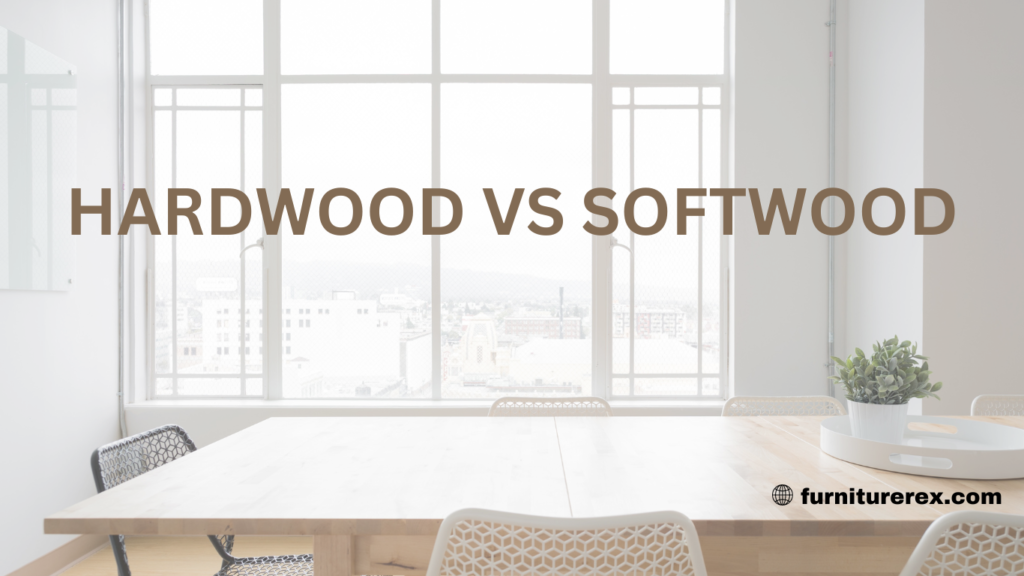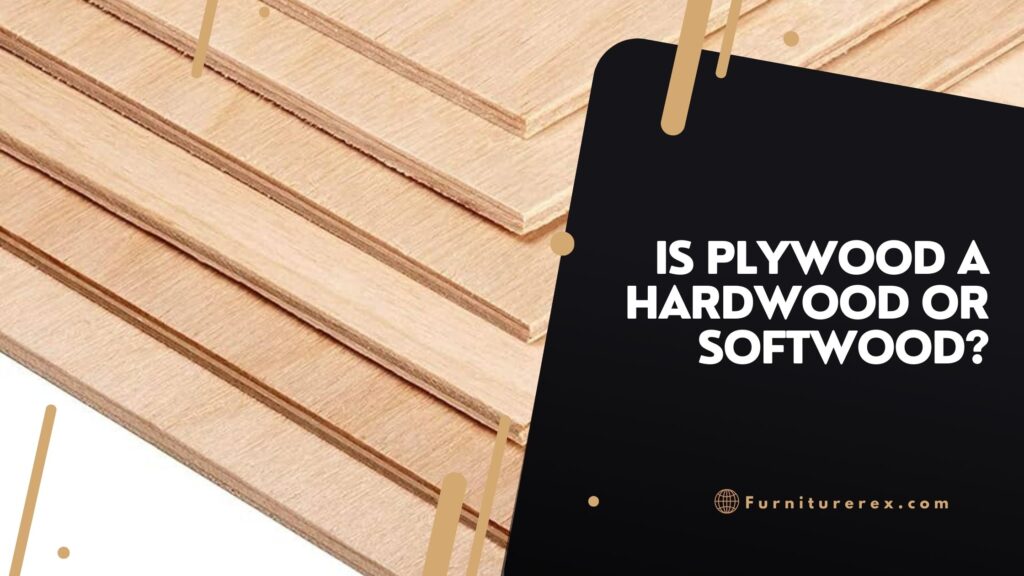Wood selection is a critical aspect of any construction or woodworking project. The choice between hardwood and softwood goes beyond mere aesthetics; it involves understanding the properties, applications, and long-term implications for your project. In this comprehensive guide, we’ll explore the differences between hardwood and softwood, their unique characteristics, and factors to consider when making the right choice.

Introductions of Hardwood Vs Softwood
Wood comes in various types, but two main categories dominate the market: hardwood and softwood. While the names might suggest hardness as the primary distinction, there’s much more to consider when choosing the right wood for your project.
Differences Between Hardwood and Softwood
Physical Characteristics
Hardwood and softwood differ in their physical properties. Hardwoods come from deciduous trees, which shed their leaves annually, and are known for their dense, sturdy nature. In contrast, softwoods are derived from evergreen trees, retaining their leaves year-round, and are generally lighter and more versatile.
Growth and Origin Distinctions
Understanding the growth patterns and origin of these woods is crucial. Hardwoods typically originate from flowering trees, growing slowly and in a more intricate manner. Softwoods, on the other hand, come from coniferous trees, growing faster and with a simpler structure.
Applications in Construction
Understanding where each wood type excels is crucial for making informed decisions in construction projects.
Hardwood Applications
Hardwoods find their place in flooring, furniture, and high-end cabinetry due to their strength and aesthetic appeal.
Softwood Applications
Softwoods are commonly used in structural framing, decking, and exterior applications, given their versatility and cost-effectiveness.
Aesthetics and Finishing
Natural Beauty of Hardwood
Hardwoods are prized for their natural beauty, intricate grain patterns, and rich colors. They often require minimal finishing to showcase their elegance.
Softwood’s Adaptability to Finishes
Softwoods, while more subtle in appearance, can adapt well to various finishes, allowing for customization to meet specific aesthetic preferences.
Cost Considerations
Price Variations Between Hardwood and Softwood
Hardwood tends to be more expensive than softwood due to its density and slower growth. However, the long-term benefits may outweigh the initial cost.
Long-Term Investment Perspective
Consider the project’s scale and duration; sometimes, the initial cost of hardwood pays off in longevity and reduced maintenance.
Is teak a hardwood or softwood?

Teak is a fascinating wood that often sparks debate over whether it is a hardwood or softwood. Despite being classified as a hardwood, teak shares some characteristics with softwoods, blurring the traditional distinction between the two categories. While teak has a high density and strength typical of hardwoods, it also possesses the natural oils and resilience commonly associated with softwoods, making it uniquely versatile in its applications. This blend of properties challenges conventional definitions and highlights the complexity of wood classification.
The debate around teak’s classification as either a hardwood or softwood speaks to the intricate nature of wood species and their diverse attributes. Traditional categorizations do not always capture the full range of characteristics present in certain woods, exemplified by teak’s hybrid nature. Recognizing these nuances invites us to reconsider our understanding of wood types and appreciate the multifaceted qualities that make each species distinct. Ultimately, embracing this complexity allows us to explore new possibilities for utilizing teak in innovative ways that leverage its unique combination of traits.
Is plywood a hardwood or softwood?

When it comes to classifying plywood as either hardwood or softwood, the answer is not straightforward. In fact, plywood can contain both hardwood and softwood layers, depending on its construction. While the outer layers of plywood are typically made from hardwood species such as oak, birch, or maple for their attractive appearance and durability, the inner core layers often consist of softwood species like pine or cedar for their strength and cost-effectiveness.
This combination of hardwood and softwood layers gives plywood a unique balance of properties that make it suitable for a wide range of applications. The hardwood outer layers provide a smooth surface finish and resistance to wear and tear, while the softwood inner layers contribute structural support and stability. As a result, plywood offers the best of both worlds, making it a versatile material in various woodworking projects.
Ultimately, rather than being strictly categorized as either hardwood or softwood, plywood represents an innovative blend of both types of wood. This hybrid nature allows plywood to exhibit characteristics from both categories and makes it valuable for diverse uses in construction, furniture making, cabinetry, and other industries where strength and aesthetics are equally important.
Is Walnut a hardwood or softwood?

Walnut is often considered a hardwood due to its density, strength, and durability. Its rich, dark color and fine grain make it a popular choice for furniture and flooring. Despite these characteristics, botanically speaking, walnut is actually a member of the hardwood family Juglandaceae. This makes it technically a hardwood, even though its wood tends to be softer than other common hardwoods like oak or maple.
When compared with traditional softwoods such as pine or cedar, walnut still stands out as harder and more resilient. However, in the grand scheme of things within the lumber industry, walnut is generally classified as a hardwood due to its botanical origins and overall density. So while some may debate whether it belongs in one category or the other based on practical use cases alone, from an academic standpoint it falls into the realm of ‘hardwood’ despite some softer qualities compared to other species in that category.
Is pine a hardwood or softwood?

The debate over whether pine is a hardwood or softwood has sparked curiosity among wood enthusiasts and industry professionals alike. While traditionally classified as a softwood due to its needle-like leaves and evergreen nature, pine possesses traits that challenge this categorization. In terms of hardness, pine falls on the softer end of the spectrum compared to true hardwoods such as oak or maple. However, its tight grain structure and durability often lead to its use in furniture-making and construction applications typically associated with hardwoods.
One perspective worth considering is that the classification of wood species as either hardwood or softwood may oversimplify their diverse characteristics. For instance, while pine may exhibit qualities typical of softwoods, such as rapid growth and light coloration, it also demonstrates some characteristics commonly associated with hardwoods – including strength, stability, and excellent workability. Perhaps a more nuanced approach to understanding wood types would involve considering each species based on its unique attributes rather than fitting it into rigid categories.
Conclusion
In conclusion, the debate between hardwood and softwood ultimately comes down to the specific needs and preferences of the individual. Hardwood offers greater density and durability, making it ideal for heavy-duty applications such as furniture and flooring. On the other hand, softwood’s affordability and versatility make it a popular choice for construction projects and outdoor structures.
Both types of wood have their own unique benefits, and the decision on which to use should be based on careful consideration of the intended use and budget. Whether you choose hardwood or softwood, it is important to support sustainable forestry practices to ensure a steady supply of quality wood for future generations. Make an informed decision that aligns with your values and project requirements.
FAQ's
Q1: How do hardwood and softwood differ in terms of physical characteristics?
A1: Hardwoods, originating from deciduous trees, are denser and more durable, while softwoods, from evergreens, are lighter and versatile.
Q2: What are the key applications of hardwood in construction projects?
A2: Hardwoods excel in flooring, furniture, and high-end cabinetry due to their strength and aesthetic appeal.
Q3: Are softwoods suitable for structural framing in construction?
A3: Yes, softwoods are commonly used in structural framing, decking, and exterior applications due to their versatility and affordability.
Q4: What factors should I consider when choosing between hardwood and softwood for a project?
A4: Consider project requirements such as durability and aesthetics, personal preferences, and the long-term investment perspective, including initial cost and maintenance.
Q5: How can I ensure the sustainability of the wood chosen for a project?
A5: Opt for certified sustainable wood options and ensure responsible harvesting practices for both hardwood and softwood.
Related Tags : Hardwood characteristics, Softwood applications, Choosing wood for projects, Wood density differences, Benefits of hardwood, Softwood vs hardwood cost, Sustainable wood options, Types of hardwood trees, Softwood uses in construction, Durable hardwood species, Softwood growth patterns, Hardwood furniture, Softwood decking, Best wood for flooring, Softwood framing, Hardwood lumber, Softwood structural applications, Hardwood vs softwood weight, Wood aesthetics comparison, Softwood advantages, Hardwood durability, Softwood versatility, Woodworking with hardwood, Softwood maintenance tips







1 thought on “Hardwood vs Softwood: Choosing the Best Wood for Your Project!”